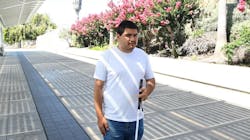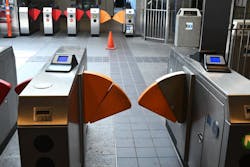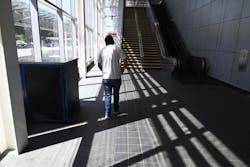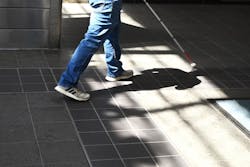BART intern efforts to empower low vision and blind BART riders
As a Bay Area Rapid Transit (BART) intern, Erik Huizar has a large task ahead of him. Over the coming months, the 19-year-old college student is visiting 20 stations around the BART system to build descriptive reports of their tactile guideways.
“I must look like such a weirdo,” Huizar said on a recent information-gathering visit to Union City Station, as he walked back and forth over the pathways.
For blind and low-vision people like Huizar, tactile guideways are guide maps to station geography that enable them to independently travel from the bus intermodal area, into the station, through the accessible fare gates, then to the foot of the stairway to the platform. On the platform, colored tactile strips denote the edge between the platforms and the trackway and mark where to board a train.
Tactile guideways often use a variety of cues for blind or low-vision riders to distinguish the pathways from the flooring around them. There is no national code or standard for these pathways, Huizar said, but typically, they are composed of materials and textures distinct from the station’s floor. Sometimes the pathways are yellow with truncated domes and other times, they may be gray and ridged or black with cones and bars.
“Basically, the architect who designs the station decides what the pathways’ patterns will be, and that’s why we have stations where either there’s no detectable path or the detectable path is more decorative than useful,” Huizar said. “Many of these stations were built a long time ago and no one really knows how to build these pathways correctly, or at least how to standardize the way to do it.”
Bob Franklin, BART’s director of customer access and accessibility, noted that in a national accessibility working group, the 40-plus public transit agencies involved “all do something different for their pathways.”
Huizar hopes his reports contribute to this still-budding body of knowledge and motivate decisionmakers to fund and improve them.
“These pathways are not as good as they can be and this is a national issue,” Huizar said.
Hulzar expects the information to be valuable to blind and low-vision BART riders, enabling them to get around a station without having to ask for help.
Tactile guideways support riders’ independence and right to affordable mobility. BART riders rely on the system to travel from place to place – to appointments, to work, to social engagements. Seven percent of BART riders report having a disability, a percentage of which who are not able to operate automobiles.
"BART is my way to get out and be independent and self-reliant," said Sheri Albers, the Community Outreach Coordinator for The Lighthouse for the Blind, during a a Fleet of the Future safety orientation BART held this past winter for the blind and low-vision community.
The orientation was followed by an online townhall BART hosted to gather input on upcoming projects and to hear directly from riders who are blind and low-vision about how it can improve accessibility services. BART plans to provide similar engagements for the deaf and hard-of-hearing and mobility-impaired communities.
"Information is powerful and we want to ally the fear in our community of taking BART,” Albers said. “Once you eliminate the fear, the world is in your hands."
To capture the necessary information for his reports, Huizar often spends hours in a station, tracing its pathways and scribbling detailed notes. He then takes his findings and drafts his report, describing things like how many sections compose the station’s pathway system, where those sections lead, and what color and material they are made of.
BART offers additional station resources for members of the blind and low-vision community, including Braille/tactile signs at station entrances and exits, at public restrooms, at the start of stairways and at emergency exits, elevators, and escalators. Every fare machine in BART stations has earphone jacks so riders can listen to its message privately. For every visual announcement in a station, there is a corresponding audio announcement. On fare gates, riders can activate a series of beeps that provide an audio code, denoting information such as whether they have enough balance on their Clipper card or if they need to tap again.
“It’s a public transportation system and it’s a federal law that we’re accessible to everyone,” Franklin said. “When we design it that way, it benefits everyone. The more universally we design something, the better it will be.”
Huizar is passionate about public transportation because he uses it to get most places. He’s working on a sociology degree and hopes to continue his studies to earn a master’s degree in orientation and mobility.
“I definitely want to focus on public transportation because that’s my favorite thing,” Huizar said.
Huizar regularly rides BART to explore new spots – mostly in search of hidden gems and great food – or to hike with his girlfriend or friends.
"There’s a little boy inside me screaming for joy every time I get on a train because it’s just a lot of fun,” Huizar said.
Huizar also acknowledged how essential public transportation is to the fabric of a well-functioning, equitable society.
“People rely on these trains, and not just people like me who can’t get around without them, but sighted people, too, who use them to visit friends and family or to get to work,” Huizar said. “Without buses, without trains, many people wouldn’t be able to do that.”
Huizar secured his BART internship in a somewhat unusual fashion, as he emailed BART General Manager Bob Powers directly after watching him and fellow transit leaders speak during a press conference for the April Transit CEO Ride-a-Long.
“A bunch of the CEOs went up and talked about accessibility and providing quality transportation is something I’m passionate about,” Huizar said. “I thought, you know, I’d really like to be involved in that.”
So, he decided to email Powers and ask for a conversation. Huizar figured he wouldn’t respond, so he hit send on the message before “chickening out.”
Two weeks later, he received an email from Alaric Degrafinried, assistant general manager of administration at BART. The gist of Degrafinried’s reply was, "When can you meet?"
After an initial phone call, Degrafinried invited Huizar to BART Headquarters.
“I was really excited; it was crazy to go to the place where everything happens,” Huizar said. “And now, I’m here and I’m uniquely suited for this because I’m someone who uses, who needs these pathways to navigate these stations, which can sometimes be very daunting and confusing for people. It would be great if people would put the effort in so people like me can find things on our own – without having to ask for help.”
BART is currently in the process of updating station platform-edge warning strips, which will soon be all bright yellow tiles with truncated domes, eliminating the black tiles, which had denoted car boarding areas. To mark platform waiting areas for door openings for the three-door train cars, BART will be installing stickers adjacent to the warning strip. The train car’s middle door will be a blue-edged sticker, to denote the dedicated space for those who use wheelchairs and other mobility devices. Additionally, at the center of the platform, there will be three-foot by four-foot yellow directional bar tiles extending from the platform edge tiles, to let blind and low vision riders know of the guaranteed boarding area, regardless of the length of the train. There is an exception to this rule, when the train is in “manual mode” and stops at the end of the platform.




